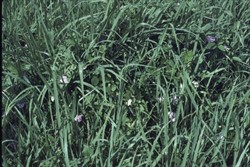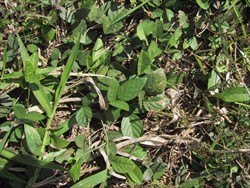Centrosema molle
Tropical Forages
Centrosema molle Mart. ex Benth.
Centrosema pubescens auct. pl.*
Note:* auctorum plurimorum (Latin: of most authors) is used to represent the most common incorrect usage of a name that has been widely used for a taxon different from the one intended by the original author.
Family: Fabaceae (alt. Leguminosae) subfamily: Faboideae tribe: Phaseoleae subtribe: Clitoriinae.
Perennial, trailing-climbing-twining herb with strong taproot system; under appropriate soil moisture conditions able to root at nodes of trailing stems. Stems slightly hairy, becoming woody when old. Leaves trifoliolate, leaflets elliptical, ovate-oblong or ovate-lanceolate, 1‒7 cm long, 0.5‒4.5 cm wide, rounded at the base and mostly acuminate at the apex, slightly hairy, especially on the lower surface; petiole up to 5.5 cm long, stipules 2‒4 mm long, persistent. Inflorescence an axillary raceme with 3‒5 papilionate flowers, light to dark lilac in colour, sometimes white; each flower subtended by two striate bracteoles; calyx campanulate with five unequal teeth; standard orbicular, up to 3 cm in diameter, hairy on the outside, bright or pale lilac on either side of a median greenish-yellow band with numerous dark violet stripes or blotches; wings and keel much smaller than the standard, directed upwards. Pod linear, compressed, 4‒17 cm long and 6‒7 mm broad, straight to slightly bent and beaked, with prominent margins, dark brown when ripe and containing up to 20 seeds. Seeds transversely oblong to squarish with rounded corners, 4‒5 mm × 3‒4 mm × 2 mm in size, brownish-black, mostly with dark mottles; approx. 40,000 seeds/kg.
Similar species
C. molle: bracts 4–6 × 1–2 mm, puberulous; pedicels 6–9 mm at anthesis; bracteoles 6–9 × 4–6 mm; seeds brownish black.
C. pubescens[1] [2]: bracts 6–9 × 3–6 mm, sericeous; pedicels 3–6 mm at anthesis; bracteoles 10–16 × 6–9 mm; seeds yellowish green.
Africa: akidi (Igbo), ewa-ahun (Nigeria)
Asia: 距瓣豆 ju ban dou (China); sentro (Indonesia); dilang-butiki, lesu-kesu, pukinggan (Philippines); ถั่วลาย thua lai (Bangkok), ถั่วสะแดด thua sa daet (Prachin Buri), thua-sentro (Thailand); day trung châu lông (Vietnam)
English: centro, butterfly-pea, centro pea, soft butterfly pea, spurred butterfly pea
French: fleur-languette, pois bâtard
Latin America: centrosema, jequirana, jetirana, jitiranu, patinho, roxinha (Brazil); bejuco chino, bejuco de chino, bejuco do chieve, bejuco do chivo, bejuco de juventud, bejuquillo, caracucha, centro, centrosema, centrosema peluda, chancho, choncho, conchita, conchitas, flor de conchitas, flor de pito, flor de pito blanco, frijol cuchillo, frijolito, gallinita, hierba jabonera, jequiritirana, patillo
Native:
Northern America: Mexico (Campeche, Chiapas, Colima, Guerrero, Jalisco, Mexico, Michoacán, Nayarit, Tabasco, Veracruz)
Caribbean: Antigua and Barbuda; Cuba; Dominican Republic; Grenada; Guadeloupe; Haiti; Jamaica; Martinique; Puerto Rico; St. Lucia; St. Vincent and Grenadines; Trinidad and Tobago
Central America: Costa Rica, El Salvador, Guatemala, Honduras, Nicaragua, Panama
South America: Bolivia; Brazil (Acre, Alagoas, Amazonas, Bahia, Ceará, Goiás, Maranhão, Mato Grosso, Minas Gerais, Pará, Paraíba, Paraná, Pernambuco, Piauí, Rio de Janeiro, Rondônia, São Paulo); Colombia; Ecuador (El Oro, Esmeraldas, Guayas, Loja, Los Ríos); French Guiana; Guyana; Peru (Amazonas, Cajamarca, Lima, San Martín, Ucayali); Suriname; Venezuela
Cultivated/naturalized:
Africa: Angola; Kenya; Cameroon; Cote d'Ivoire; Equatorial Guinea; Gabon; DRC; Ghana; Guinea; Guinea-Bissau; Liberia; Mozambique; Nigeria; São Tomé and Príncipe; Sierra Leone; Tanzania; Togo; Uganda: Zambia; Zimbabwe
Indian Ocean: Mauritius; Réunion
Asia: Brunei; Christmas Island; India; Indonesia; Malaysia; Singapore; Sri Lanka; Taiwan
Papuasia: Papua New Guinea; Solomon Islands
Australasia: Australia (Queensland, Northern Territory)
Pacific: Fiji; Guam; Micronesia
Forage
In grazed pastures in mixture with grasses or as legume-only protein bank; also as cut-and-carry forage, mainly for fresh consumption.
Environment
In SE Asian tree plantations, often in a ground cover mixture with other legume species. Soil improvement when used as ground cover and green manure. Reduction of herbicide use when used as cover crop for weed control.
Other
Folk medicinal application for treatment of wounds.
Soil requirements
In general, well-drained soils of medium to high fertility but some germplasm is also adapted to acid soils of lower fertility; some tolerance of water-logging.
Moisture
Most productive under high rainfall conditions (>1,500 mm/year), but because of its taproot system, able to persist also under dry-subhumid conditions with 3‒5 dry months.
Temperature
Grows from sea level to 1,600 m asl between 22º N and 22º S. Warm season growth only.
Light
Shade-tolerant, can persist under 80% shade.
Reproductive development
An indeterminate legume. Flowering is induced mainly by photoperiod (short days), but is also favoured by water stress.
Defoliation
Persists under proper grazing and fertilizer management, but is sensitive to overstocking.
Fire
Tolerates lenient fire when established; plant population can also regenerate from soil seed bank.
Guidelines for establishment and management of sown forages.
Establishment
In spite of being promiscuous, inoculation of seed with an effective Bradyrhizobium strain is recommended in Australia to optimize establishment. Seeding rate: 3‒5 kg scarified seed/ha or more, e.g., when broadcast; full seedbed preparation recommended, sod-seeding also possible. Slow to establish but on good soils, under appropriate moisture conditions and in pure stands, forming a 40‒50 cm thick ground cover 4‒8 months after sowing.
Fertilizer
With effective Bradyrhizobium strains (e.g. CB 1923 and 2947), nitrogen fixation estimates 70‒280 kg/ha/year in grazed mixtures with grasses; sensitive to P, K, Ca, Mo deficiency.
Compatibility (with other species)
Quite compatible depending on management (i.e., proper fertilization and stocking); e.g., persisted in the humid tropics of Australia for more than 11 years in mixture with Megathyrsus maximus.
Companion species
Grasses: The most suitable grass partner is Megathyrsus maximus; other suitable tussock grasses are reported to be Andropogon gayanus, Cenchrus purpureus, Chloris gayana, Hyparrhenia rufa, Melinis minutiflora, Paspalum dilatatum.
Legumes: As ground cover in southeast Asian plantation agriculture, often in a species mixture with Neustanthus phaseoloides, Calopogonium mucunoides and , also Grona heterocarpa ssp. ovalifolia.
Pests and diseases
Relatively insensitive, but can be affected by Cercospora leaf spot, anthracnose, Rhizoctonia foliar blight, red-spider mites.
Ability to spread
Fairly good, by seed.
Weed potential
In some areas of West Africa considered a weed.
Dry matter
In pure stands, up to 12 t DM/ha/year possible; in mixed pastures, 1‒3 t/ha/year (humid tropics, Australia).
Animal production
260‒600 kg/ha/year LWG reported for mixtures with a grass (e.g., Megathyrsus maximus; humid tropics in Australia, SE Asia); with daily LWG of 400‒600 g/animal under proper grazing management; carrying capacity in the humid tropics can be 900‒1,000 kg LW/ha.
High seed production potential when grown on trellises (200 to >1,000 kg/ha possible, depending on harvesting method); hardseededness (up to >60%) is common.
There is some tolerance to low doses of 2,4-D.
- High quality.
- High seed production potential.
- High soil requirements.
- Slow establishment.
- Management-dependent lack of persistence because of high palatability.
Fantz, P.R. (1996) Taxonomic notes on the Centrosema pubescens Bentham [1] [2] complex in Central America (Leguminosae: Phaseoleae: Clitoriinae). SIDA, Contributions to Botany 17:321–332. jstor.org/stable/41967213
Keller-Grein, G., Schultze-Kraft, R., Franco, L.H. and Ramírez, G. (2000) Multilocational agronomic evaluation of selected Centrosema pubescens germplasm [1] [2] on acid soils. Tropical Grasslands 34:65–77. goo.gl/YOtVsj
Schultze-Kraft, R. and Clements, R.J. (eds). (1990) Centrosema: Biology, agronomy, and utilization. CIAT Publication No. 92. Centro Internacional de Agricultura Tropical (CIAT), Cali, Colombia. hdl.handle.net/10568/54383.
Skerman, P.J., Cameron, D.G. and Riveros, F. (1988) Tropical forage legumes, 2nd edn. Food and Agriculture Organization of the United Nations (FAO), Rome, Italy. p. 243–255.
Teitzel, J.K. and Chen, C.P. (1992) Centrosema pubescens Benth[1] [2]. In: Mannetje, L.’t and Jones, R.M. (eds) Plant Resources of South-East Asia No. 4. Forages. Pudoc Scientific Publishers, Wageningen, the Netherlands. p. 86–88. edepot.wur.nl/327785
Teitzel, J.K., Wilson, R.J. and Mellor, W. (1991) Productive and stable pasture systems of cattle fattening in the humid tropics. I. Field testing on a naturally fertile site. Agricultural Systems 36:251–265. doi.org/10.1016/0308-521X(91)90009-Y
'Common centro' Used in Australia. No formal release; origin unknown.
'Centrosema Comum' Used in Brazil. No formal release; origin unknown.
'El Porvenir' Released in Honduras (1990). Origin: Colombia.
'Villanueva' Released in Cuba (1993). Origin not reported.
'Cardillo' (Q 25261) Released in Australia (1995). Selected for white flower colour from CPI 43197, a vigorous accession with strong stolon development. Origin Santa Cruz de la Sierra, Bolivia (17°49' S, 425 m asl, rainfall 1,250 mm; combines well with Urochloa decumbens.
'Barinas' (CIAT 15160) Released in Southeast Asia (second half of 1990s). No formal release; origin Barinas, Venezuela (8°20' N, 69°33' W; 180 m asl; rainfall1,560 mm/yr); selected for good acid soil adaptation; shows wide adaptability and vigour across different soils and climates.
CIAT 5169, CIAT 5172, CIAT 5634, CIAT 15150, CIAT 15160, CIAT 15470, CIAT 15872 Selected in several countries in tropical America. Good acid-soil adaptation, wide adaptability and vigour across different soils and climates; some with stoloniferous growth habit.
Large, quite variable germplasm collection is available at CIAT (Cali, Colombia) for screening for adaptation to particular environments/niches.
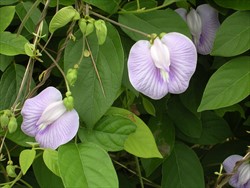
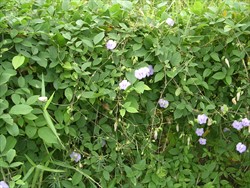
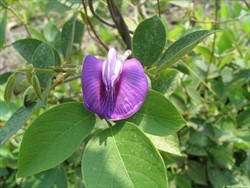
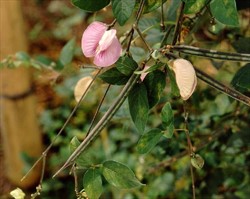
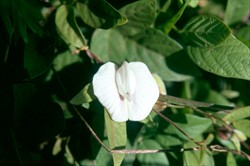
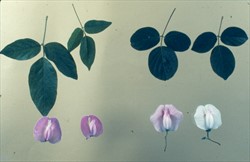

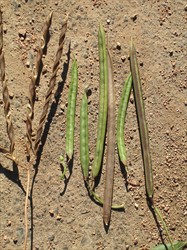
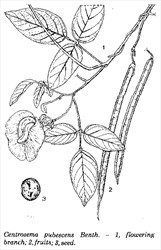
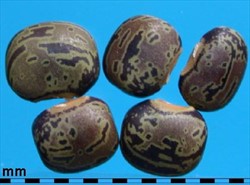
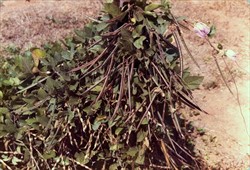
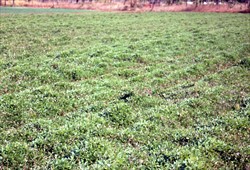
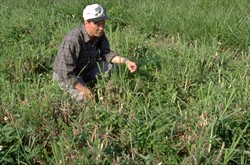 C.molle in stable mixture with Napier grass after 5 years of cutting. Northern Vietnam
C.molle in stable mixture with Napier grass after 5 years of cutting. Northern Vietnam